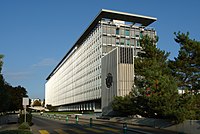
Photo from wikipedia
Abstract Risk to public health related to the presence of ochratoxin A (OTA) in wines from Fruska Gora was assessed on the basis of 113 dry wines from vintages spanning… Click to show full abstract
Abstract Risk to public health related to the presence of ochratoxin A (OTA) in wines from Fruska Gora was assessed on the basis of 113 dry wines from vintages spanning 2011–2016, analysed by immunoaffinity and liquid chromatography with fluorescence detection. More than a half of sampled wines (52.2%) contained OTA in quantifiable amounts (above 0.02 μg/L). Almost 64% of red wines had at least trace amounts of OTA, while the percentage of white and rose wines was considerably lower (42.6% and 36.4%, respectively). The maximum concentration of OTA (0.134 μg/L) was far below the regulatory limit. Occurrence and common OTA content between vintages was diverse, and 2014 year's samples were particularly distinguished due to the highest average OTA amount (0.035 μg/L). For risk characterization a margin of exposure approach was applied, in respect of non-neoplastic and neoplastic effects. Results revealed a very low risk to public health related to the exposure to OTA, regardless of wine consumption pattern. Thus, potential health benefits of responsible wine consumption, related mostly to the prevention of cardiovascular diseases, outweigh the risk, providing a base for international recognition and promotion of the regional wines and wine tourism.
Journal Title: Lwt - Food Science and Technology
Year Published: 2020
Link to full text (if available)
Share on Social Media: Sign Up to like & get
recommendations!